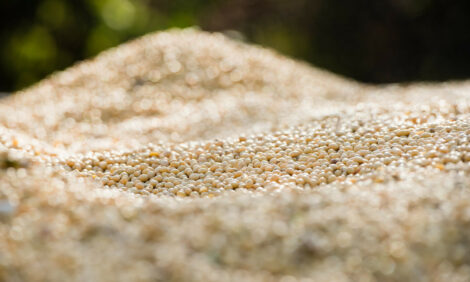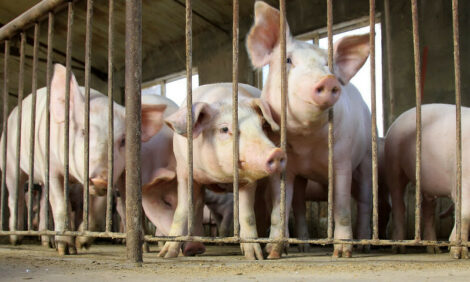



December Pig Crop Down 1 Percent
US - January 2003 Hogs and Pigs report from the USDA National Agricultural Statistics Service and commentary from Ron Plain.USDA November Hogs and Pigs Report
The December 2002 U.S. pig crop at 7.95 million head, was 1 percent below the previous year.Sows farrowing during this period totaled 905 thousand head, 2 percent below last year.
The average pigs per litter for December increased to 8.78, compared to 8.66 last year.
The U.S. inventory of sows and gilts on January 1, 2003, was 5.84 million head, down 3 percent from January 1, 2002.
U.S. sows and gilts bred during December totaled 1.17 million head, down 2 percent from the previous year.

Commentary on the report - Ron Plain
 Ron Plain |
USDA's January hogs and pigs report was not as encouraging as we had hoped. Pigs per litter during December (8.78) were up 1.4% from a year ago. That is the biggest year-over-year increase since January 2000. It is possible the increase in pigs per litter was due to mild weather in December and January's unusually cold weather will have the opposite impact. Nonetheless, the December 2002 pig crop was only 0.6% smaller than December 2001. This is a smaller year-over-year drop than in the previous six monthly pig crops.
The rest of USDA's numbers were in line with pre-release estimates. USDA said the inventory of sows and gilts held for breeding was 3.1% smaller than last January 1.
Producers bred 2.4% fewer sows and gilts during December than a year earlier. This is consistent with the December quarterly inventory report that predicted March-May farrowings would be down 2.5%.
Litters farrowed during December were down 2.0%. This is consistent with the winter farrrowing intentions in the last quarterly report (down 1.6%).
The July pig crop (98.7%) implied that January 2003 slaughter of U.S. hogs would be smaller than January 2002. Preliminary data indicates daily hog slaughter was up 1.5% in January.
The August pig crop (99.0%) implies that February hog slaughter will be even to slightly smaller than February 2002. (Increasing imports of live hogs and pigs from Canada usually mean actual slaughter is a bit higher than implied by the size of the U.S. pig crop.) Terminal market barrows and gilts averaged $38.16/cwt in February 2002. We are expecting February 2003 hog slaughter to be close to last year and live hog prices to average slightly below February 2002.
The September pig crop (99.2%) implies that March hog slaughter will be close to that of March 2002. Terminal market barrows and gilts averaged $35.34/cwt in March 2002. If March hog slaughter is unchanged from a year earlier look for live prices in the upper $30s. A 2% increase in March slaughter should yield live hog prices in the mid $30s.
The October-December pig crop (97.7%) suggests April-June hog slaughter will be down 2% or so compared to the same three months in 2002. This should mean live hog prices mostly in the low $40s. If slaughter comes in up 2%, look for live hog prices in the spring of 2003 to average in the upper $30s.
The number of sows and gilts bred has been below year earlier levels for the last seven months according to these USDA producer surveys. Given all the red ink that producers accumulated in 2002, matings should stay below year earlier levels for the rest of 2003.
SowsFarrowed Pigs/ --Pig Crop-- Females Bred 000s %YrAgo Litter 000s %YrAgo 000s %YrAgo ------------ ------ ------------ ------------ Dec02 905 98.0 8.78 7946 99.4 1165 97.6 Nov02 926 96.5 8.83 8176 96.3 1170 97.5 Oct02 940 97.6 8.83 8300 97.4 1175 98.2 Sep02 951 98.4 8.85 8416 99.2 1145 97.8 Aug02 946 99.2 8.88 8405 99.0 1120 98.9 Jul02 949 98.8 8.86 8408 98.7 1145 99.1 Jun02 938 97.4 8.85 8301 97.4 1168 97.6 May02 982 102.5 8.81 8651 101.5 1170 100.4 Apr02 983 103.1 8.85 8700 102.6 1173 100.3 Mar02 978 102.0 8.80 8608 101.2 1181 100.5 Feb02 967 102.8 8.83 8543 103.3 1156 101.2 Jan02 946 104.4 8.73 8257 104.7 1190 101.8 Dec01 923 102.4 8.66 7994 102.4 1194 100.8 Nov01 960 103.4 8.84 8488 103.3 1200 102.7 Oct01 963 102.4 8.85 8523 102.5 1197 102.0 Sep01 966 99.6 8.78 8481 98.9 1171 101.0 Aug01 954 99.5 8.90 8491 100.0 1133 NA Jul01 961 99.1 8.87 8522 99.3 1155 NA Jun01 963 100.3 8.85 8526 100.6 1197 NA May01 958 100.3 8.90 8525 100.7 1165 NA Apr01 953 99.7 8.90 8481 100.2 1170 NA Mar01 959 98.5 8.87 8503 98.4 1175 NA Feb01 941 97.5 8.79 8273 97.9 1142 NA Jan01 906 99.5 8.71 7887 98.9 1169 NA |
Report Tables


Special Note
Monthly farrowing and pig crop estimates are preliminary and may be revised in the Quarterly Hogs and Pigs Reports. Various factors can require revisions, such as sample variability, difference in reporting time-frame (monthly vs. quarterly), and pre-weaning and post-weaning death loss. Please refer to the Revision Policy on below for more information.
Reliability of January 2003 Hogs and Pigs Estimates
Survey Procedures: A random sample of 2,900 U.S. producers from contractors to independent producers were used to provide data for these estimates. Survey procedures ensured that all breeding and farrowing operations, regardless of size, had a chance to be included in the survey. Large producers were sampled more heavily than small operations. Data were collected during the first-half of the month by mail, telephone, and face-to-face personal interviews. Operations were asked to provide information on sow and gilt inventories as of the first of the month, sows and gilts bred during the previous month, sows and gilts farrowed during the previous month, and the pig crop from these litters.Revision Policy: Revisions to previous monthly estimates are made during the quarterly report. These revisions are to improve month to month, and quarter to quarter relationships. In December, estimates for all months and quarters of the current and previous year are reviewed. The reviews are primarily based on hog check-off receipts and slaughter. Estimates will also be reviewed after data from the Department of Agriculture five-year Census of Agriculture are available. No revisions will be made after that date.
Reliability: Since all operations with sow and gilt inventory are not included in the sample, survey estimates are subject to sampling variability. Survey results are also subject to non-sampling errors such as omissions, duplication, and mistakes in reporting, recording, and processing the data. The affects of these errors cannot be measured directly. They are minimized through rigid quality controls in the data collection process and through a careful review of all reported data for consistency and reasonableness.
Source: January 2003 Monthly Hogs and Pigs Report - USDA National Agricultural Statistics Service







